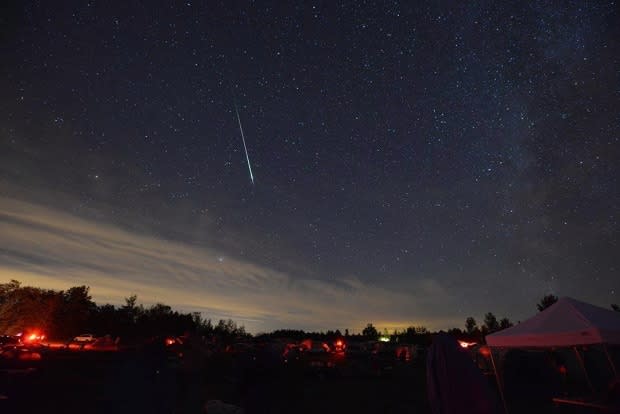Annual Perseid meteor shower peaks this week: How you can catch some 'shooting stars'
Looking for a fun, physical-distancing activity in the coming days? The best meteor shower of the year is upon us.
The Perseid meteor shower is one of the best summertime treats. Under optimal conditions — clear, moonless dark skies — at its peak, the shower can produce up to 100 meteors an hour.
The meteor shower runs from July 17 to Aug. 26, with the peak occurring this year on the night of Aug. 11–12.
Meteor showers occur when Earth, as it orbits the sun, plows through debris left over from a passing comet or asteroid. These small, grain-sized pieces of debris burn up in our atmosphere, produce beautiful streaks of light, often referred to as "shooting stars."
In this case, Earth is passing through a stream left from comet 109P/Swift-Tuttle.
Try out this interactive map showing how Earth passes through the meteor shower:
When and where to watch
While last year's shower was hampered by an almost full moon, the good news is that this year, the moon will only be 44 per cent illuminated and rise after midnight.
The biggest key to enjoying a meteor shower is getting away from light sources. That means finding a good, dark-sky location, such as a park or a beach. Also, stay away from your cellphone. As it takes our eyes some time to adjust to the dark, the phone's bright light will make it more difficult to do so. Typically, it can take 30 minutes or longer for your eyes to adjust.
The greatest thing about meteor showers is that everyone can enjoy them. There's no need for a telescope or even binoculars. All you need to do is grab a blanket or two, find a good location and look up.

See some 'Earth-grazers'
Meteor showers are named after the constellation from which the meteors seem to originate, called the radiant. In this case, the radiant is in the constellation Perseus, hence the name.
The constellation rises in the northern sky at about 9:30 p.m. local time and continues to rise in the northeast. But you don't have to look exactly in that direction to see the meteors. You can simply look up.
In fact, if you're doing your meteor-gazing at that time of night, the meteors will leave much longer trains — or streaks — in the sky as they skim the upper atmosphere. These are called "Earth-grazers" and can be seen low in the east moving from north to south. Though earlier in the night isn't the most active time for meteors, the ones that you will see will likely be more spectacular as a result.
And you don't have to look straight up because more meteors will be seen at somewhat lower elevations.
As the constellation rises higher in the sky, you will likely see more meteors. Of course, as the constellation rises, so, too, does the moon. That means that only the brightest meteors will be visible. The good thing is, the Perseids do tend to put on a show with some brilliant meteors seen even over urban areas.
Now, if the weather doesn't look like it'll hold up, you can try watching on either side of the peak night, on Monday or Wednesday when meteor activity will still be high.
And, if you're willing to go the distance, you can pull an all-nighter or wake up very early in the morning, as the best time to see meteors will be in the few hours before sunrise on Wednesday.

